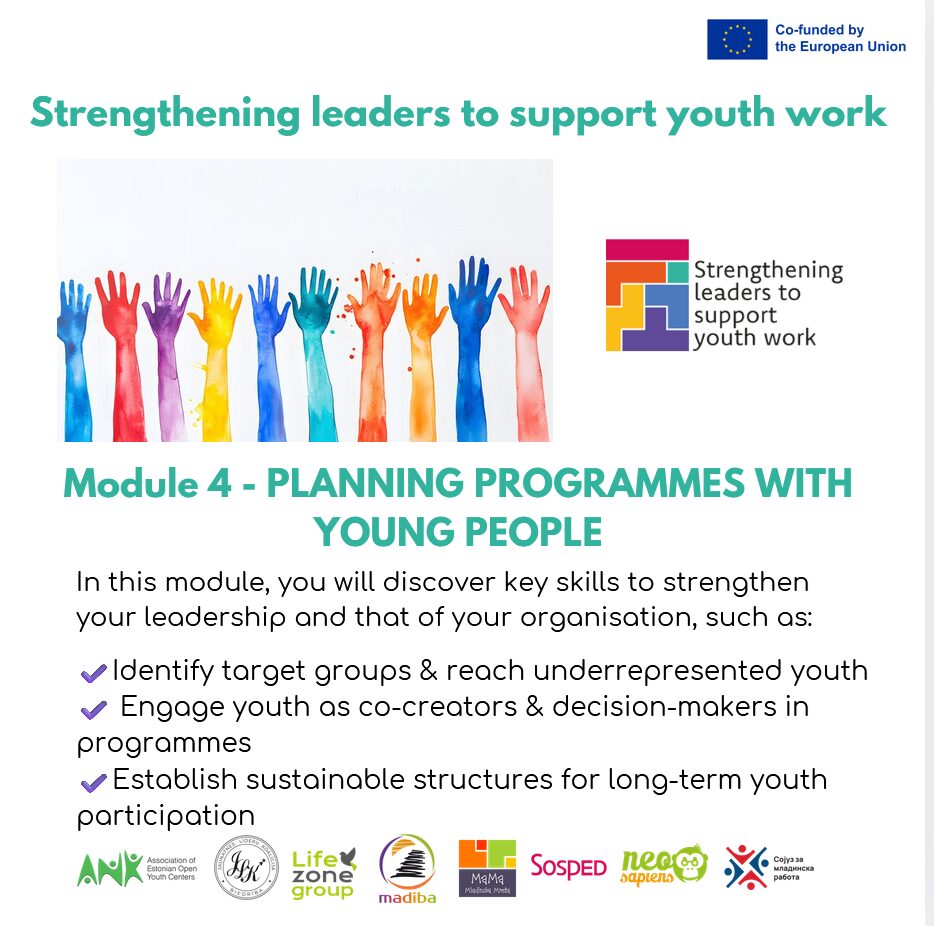
MOdule 4 - PLANNING PROGRAMMES WITH YOUNG PEOPLE
Introduction and main ideas
The youth sector is fundamentally rooted in the active involvement of young people, recognizing that young people are not only participants in programs but co-creators of the ideas, activities, and projects that define youth work. For youth centres and organizations to be truly effective, it is essential to plan and design programs together with young people, ensuring their voices are heard and their ideas are reflected in the organization’s goals and activities.
As leaders (directors and managers) in the field of youth, it is crucial to understand that youth[1] participation is not optional; it is foundational to the very essence of youth work. The engagement of young people in co-designing programs of organisations (activities, events, projects …) fosters a sense of ownership and identification with the activities and projects of youth work. This sense of ownership is what inspires young people to participate more meaningfully, develop their skills, and contribute to their communities. Without it, youth work risks becoming disconnected from the very group it aims to serve.
Youth workers are often the first point of contact for young people in the community. They act as bridges, connecting young people with opportunities, resources, and platforms for self-expression. However, the effectiveness of youth workers depends on the guidance and vision of organizational leadership. Leaders play a vital role in directing youth workers, not only in their day-to-day interactions with young people but also in their approach to co-planning and co-creating programs. It is the responsibility of leaders to ensure that youth workers have the tools, training, and encouragement needed to involve young people actively in shaping the organization’s programs.
When young people see that their voices are valued and their input to program creation has a tangible impact, they are more likely to engage fully with the organization’s work. This identification with the activities and projects of youth work is the foundation of meaningful youth engagement and the bedrock of successful youth work in local communities. Furthermore, fostering a culture of participation not only strengthens young people’s connection to the organization but also enhances the recognition of youth work at the local level and beyond. By demonstrating the positive outcomes of participatory practices, organizations become a model of effective youth engagement, contributing to the visibility and credibility of the youth work sector as a whole. By focusing on youth participation, organisations are not only empowering young people but also ensuring the sustainability and relevance of their programs.
This training will equip leaders with the knowledge, tools, and strategies needed to assess the current level of youth participation and to embed youth participation at every level of their organization, from daily activities to long-term strategic planning.
Through this module, leaders will:
- Understand the Foundations of Youth Work & Participation: Explore the importance of youth participation, apply key models such as Hart’s Ladder and Shier’s Pathways, and evaluate the organization’s current approach.
- Define the Target Group & Organizational Approach: Identify the young people the organization serves, assess gaps in engagement, and refine outreach strategies to reach underrepresented groups.
- Research Youth Needs & Adapt Programs: Apply practical methods for assessing youth needs through participatory research, ensuring that programs are relevant and responsive to young people’s realities.
- Engage Young People in Co-Creation: Implement co-creation techniques that shift young people from participants to active decision-makers, strengthening program impact and fostering long-term engagement. Establish structures to institutionalize youth participation, create youth advisory boards, and build sustainable frameworks for shared decision-making.
By the end of this training, leaders will have a clear action plan to embed youth participation within their organization, ensuring that programs (activities, events, projects … that the organisation implements) are inclusive, effective, and aligned with the needs of young people.
Aims of the training module
Learning objectives of the module Planning programs together with young people:
- Assess the organisation’s current level of youth participation using established models.
- Analyze barriers to youth involvement in program planning and develop strategies to enhance youth participation.
- Apply co-creation principles in the organisation’s planning processes.
- Implement concrete changes in organisational structures to improve youth-led program development.
- Evaluate the impact of youth co-creation in programs and adjust approaches accordingly.
- Indirectly: Raise the profile and recognition of youth work and the organisation itself.
Required knowledge
To get the most out of this module, it may be useful to have a basic understanding of:
- The principles of youth work and non-formal education. Suggested reading: European Youth Work Policy Goals
- Models of youth participation such as Hart’s Ladder and Shier’s Pathways to Participation. Downloadable resource available in module - section 4.2.\
- The role of youth sector organizations in fostering active citizenship and participation.
[1] There is no universal consensus on what “youth” is. Youth is socially constructed and refers to the period of complex transitions to autonomy, from childhood to adulthood. Definitions of young people vary between countries. The age range 15-29 is often selected for statistical purposes at EU level. Under the Erasmus+ programme, various opportunities are available for young people aged 13 to 30. The Council of Europe youth sector’s activities are available for young people aged 18 to 30, with justified exceptions (Lavchyan & Williamson, 2019, 6)
 WAY TO TH!NK
WAY TO TH!NK